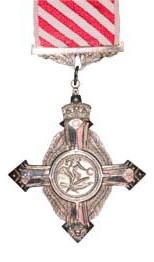Air Force Cross (AFC)

Awarded for acts of valour, courage or devotion to duty when flying by officers and warrant officers, but not in active operations against the enemy. A bar is added for those awarded further AFCs.
First established
By King George V, 3 June 1918, after the formation of the RAF (Gazette issue 30723).
‘The three Warrants set forth below are concerned with the establishment of the Distinguished Flying Cross, the Air Force Cross, the Distinguished Flying Medal and the Air Force Medal, the institution of which was announced in the London Gazette of 3rd June, 1918.’ (Gazette supplement 30723)
WW1 recipients
Lt William Ronald Read, RAF, gazetted 1 January 1919
Awarded the AFC 3 times, and one of the few to receive the AFC and 2 bars for services after the war (service in Palestine, 1920, Gazette issue 13615), also MC (Gazette supplement 29438) and DFC (Gazette supplement 31378) for services in France.
First awarded (Gazette supplement 31098), with a first bar 12 July 1920, ‘Flight Lieutenant William Ronald Read, M.C., D.F.C., A.F.C. (216 Sqn., Palestine (Ist D. Gds.)’ (Gazette supplement 31974). The second bar was awarded in 1921 (Gazette supplement 32563).
Read was raised by guardians after both his parents died when he was just 12 years old. He was an amateur steeplechase rider who kept diaries during the war that are now held by the Imperial War Museum.
Cpt Stanley Cockerell, RAF, gazetted 12 July 1920
Cockerell was a Royal Flying Corps aircraft mechanic before becoming a fighter pilot. He achieved 7 aerial victories while flying the Airco DH.2, DH.5 and Sopwith Camel. After the war, he attempted the first flight from Cairo to Cape Town as a test pilot for Vickers, for which he was awarded the AFC (Gazette supplement 31974).
Cockerell and his daughter, aged only 6, were killed during the Luftwaffe bombing of Sunbury-on-Thames in November 1940.
